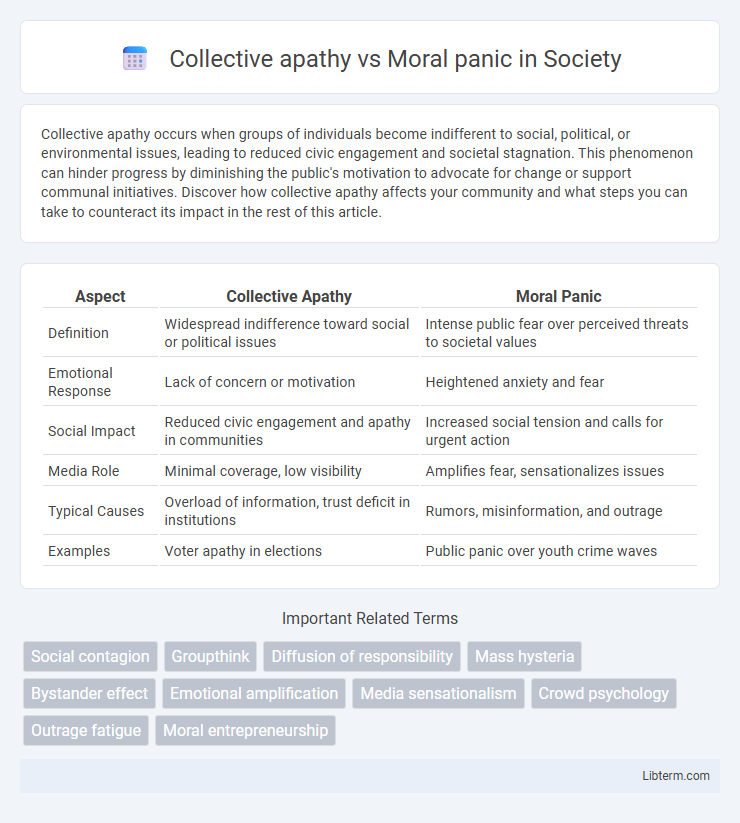Collective apathy occurs when groups of individuals become indifferent to social, political, or environmental issues, leading to reduced civic engagement and societal stagnation. This phenomenon can hinder progress by diminishing the public's motivation to advocate for change or support communal initiatives. Discover how collective apathy affects your community and what steps you can take to counteract its impact in the rest of this article.
Table of Comparison
| Aspect | Collective Apathy | Moral Panic |
|---|---|---|
| Definition | Widespread indifference toward social or political issues | Intense public fear over perceived threats to societal values |
| Emotional Response | Lack of concern or motivation | Heightened anxiety and fear |
| Social Impact | Reduced civic engagement and apathy in communities | Increased social tension and calls for urgent action |
| Media Role | Minimal coverage, low visibility | Amplifies fear, sensationalizes issues |
| Typical Causes | Overload of information, trust deficit in institutions | Rumors, misinformation, and outrage |
| Examples | Voter apathy in elections | Public panic over youth crime waves |
Understanding Collective Apathy and Moral Panic
Collective apathy refers to the widespread indifference or lack of concern within a group about social issues, often resulting in inaction despite potential harm. Moral panic describes an intense public reaction fueled by media and societal groups, exaggerating threats to social order. Understanding these phenomena involves recognizing how collective apathy diminishes social engagement, whereas moral panic can distort perceptions and provoke disproportionate responses.
Defining the Key Concepts
Collective apathy refers to a widespread lack of interest or concern among a group or society toward significant issues, leading to inaction or indifference. Moral panic describes an intense, disproportionate public reaction to a perceived threat that challenges societal norms, often amplified by media and influential figures. Understanding these concepts highlights contrasting social responses: widespread disengagement versus heightened fear and urgency.
Historical Perspectives on Social Reactions
Historical perspectives reveal collective apathy as widespread societal indifference during major crises, such as the initial public response to the Great Depression, where economic hardships were often met with resignation rather than activism. In contrast, moral panic frequently mobilized rapid collective anxiety exemplified by the Salem witch trials or Red Scare era, where fears of subversion led to intense social and legislative reactions. These contrasting social reactions highlight how varying historical contexts shape public perception and policy, influencing how societies prioritize threats or ignore systemic issues.
Psychological Drivers Behind Apathy and Panic
Collective apathy often stems from psychological drivers such as cognitive overload, emotional numbing, and diffusion of responsibility, leading individuals to disengage from pressing social issues. In contrast, moral panic arises from fear amplification, social identity threats, and the human tendency to seek order, prompting exaggerated reactions to perceived threats. Understanding these distinct psychological mechanisms is crucial for addressing public responses to crises and fostering balanced societal awareness.
Media’s Role in Shaping Social Responses
Media significantly influences collective apathy and moral panic by framing events in ways that either minimize threats or exaggerate dangers. Sensationalized reporting and repeated negative imagery amplify moral panic, driving public fear and reactive policies, while underreporting or trivializing issues fosters collective apathy, reducing engagement and urgency. Algorithms prioritize emotionally charged content, reinforcing polarized responses and shaping social behavior through selective exposure and agenda-setting.
Case Studies: Real-World Examples
The 1980s moral panic surrounding satanic ritual abuse in the United States exemplifies how fear-driven narratives can lead to widespread social hysteria despite a lack of empirical evidence. In contrast, collective apathy is evident in the global response to climate change warnings, where despite scientific consensus and urgent data, large-scale public and political inaction persists. These case studies highlight the contrasting societal reactions: moral panic triggers immediate but often irrational action, whereas collective apathy results in prolonged neglect of critical issues.
Impacts on Policy and Governance
Collective apathy often leads to policy stagnation and weakened governance as public disengagement reduces pressure on officials to address critical issues. In contrast, moral panic can drive hasty policy decisions, sometimes resulting in overregulation or infringement of civil liberties due to heightened fear among policymakers and the public. Balancing these extremes is essential for effective governance, ensuring responsive yet measured policy outcomes.
Societal Consequences of Inaction vs. Overreaction
Collective apathy leads to societal consequences such as the neglect of critical issues like climate change and public health, resulting in long-term harm and weakened social cohesion. Moral panic triggers overreaction, causing disproportionate responses including policy overreach, stigmatization of marginalized groups, and erosion of civil liberties. Balancing awareness without falling into apathy or panic is vital to fostering constructive social action and maintaining democratic stability.
Strategies to Balance Awareness and Rationality
Balancing awareness and rationality in addressing collective apathy and moral panic requires strategic communication that emphasizes factual information paired with empathetic engagement. Implementing media literacy education helps the public critically evaluate sensationalized narratives, reducing irrational fear while preventing disengagement from important social issues. Encouraging community dialogues fosters inclusive understanding and promotes measured responses, ensuring awareness translates into thoughtful action rather than emotional extremes.
Moving Toward Informed Collective Action
Collective apathy leads to social inaction and reinforces systemic issues through widespread indifference, while moral panic triggers exaggerated fear and reactionary policies that may harm communities. Moving toward informed collective action requires fostering critical media literacy and inclusive dialogue to balance emotional responses with evidence-based understanding. Engaging diverse stakeholders promotes proactive solutions that address root causes and sustain meaningful social change.
Collective apathy Infographic

 libterm.com
libterm.com